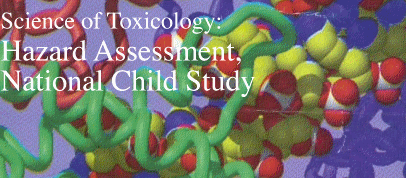 |
||||


Risk Assessment is another type of causation: predicting whether an exposure, usually in a population rather than a single individual, will increase the risk of developing some adverse health effect, without necessarily determining whether such health effect actually occurs. Risk means that all such exposed individuals are more likely to develop an adverse effect, but it does not mean that any particular individual will or even that the majority of individuals will. Smoking, for example, increases risk of lung cancer from approximately one in 100 to 1 in 10--a signficiant increase. Nevertheless, ninety percent of smokers do not develop lung cancer, even though they are all at increased risk. Risk Assessment is used by regulatory agencies, such as the EPA, to determine how much of a chemical can be released into the environment without causing an unacceptable increase in risk of an adverse effect. 'Unacceptable' is more of a policty decision than a scientific one.
Specific causation analysis can be divided into the following three components:
(1) Hazard Assessment
(2) Exposure Assessment
(3) Health Assessment
(1) Hazard Assessment: what harm can the chemical cause, based on intrinsic toxicity and circumstnaces of exposure, form of chemical (gas, liquid, solid) and susceptibility of individual.
(2) Exposure Assessment how much of the chemical is in a media (air, water, food, soil) available to be taken into the body? Is this a one-time or multiple exposure? Does it occur over a short period of time (acute) or over many months or years (chronic)? How does the length of exposure affect the toxicity of the chemical? How much of the chemical gets absorbed into the body (dose), and where in the body does it end up (distribution and target organ/tissue)?
(3) Health Assessment: what type of health effect develops (or gets exacerbated), and does this occur immediately or after a delay (lag time)? Is this a new effect in the individual or is there a history of this type of problem, made worse by the chemical exposure? Is the individual in a high risk group (in utero, infant, elderly, reduced immune function)? Are there other (alternative) known causes for this problem and were these causes present ?
Hazard Assessment
What is the National Children’s Study?
The National Children’s Study will examine the effects of environmental influences on the health and development of more than 100,000 children across the United States, following them from before birth until age 21. The goal of the study is to improve the health and well-being of children.
The study defines “environment” broadly and will take a number of issues into account, including:
• Natural and man-made environment factors
• Biological and chemical factors
• Physical surroundings
• Social factors
• Behavioral influences and outcomes
• Genetics
• Cultural and family influences and differences
• Geographic locations
Researchers will analyze how these elements interact with each other and what helpful and/or harmful effects they might have on children’s health. By studying children through their different phases of growth and development, researchers will be better able to understand the role of these factors on health and disease. Findings from the study will be made available as soon as possible as the research progresses.
The study will also allow scientists to find the differences that exist between groups of people, in terms of their health, health care access, disease occurrence, and other issues, so that these differences or disparities can be addressed.
The National Children’s Study will be one of the richest information resources available for answering questions related to children’s health and development and will form the basis of child health guidance, interventions, and policy for generations to come. It is anticipated that the preliminary results from the first years of the study will be available in 2008-2009.
[The above provides excerpts from National Child Study, web site. ]
http://nationalchildrensstudy.gov/about/mission/overview.cfm